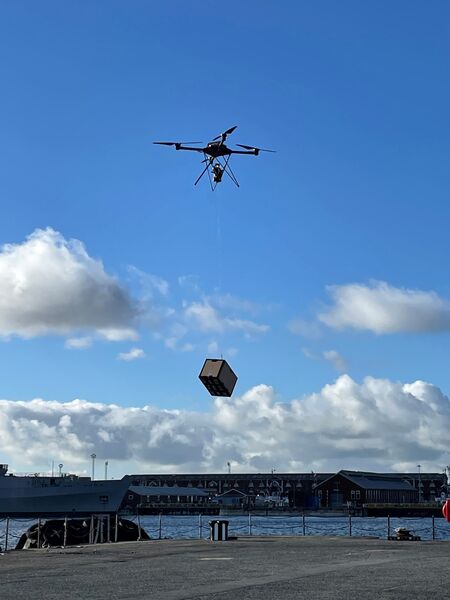- About
- Intara
- Capabilities
- Advisory
- Resources
- News
- Store
24 November 2022
Autonomous UAV winch trialled at AWE for British Army
by Olivia Savage


Sparrow (pictured), attached to a third-party UAV, which is lifting a 5 kg mock payload. (Janes/Olivia Savage)
A novel air-ground payload transfer device intended for unmanned aerial vehicles (UAVs) has been trialled at the British Army Warfighting Experiment (AWE) Sustain & Protect (S&P) programme at Portsmouth Naval Base.
During AWE on 22 November, BMT Global demonstrated Sparrow, a prototype robotic unit that enables the autonomous delivery and collection of payloads from a UAV.
Attached to a UAV, Sparrow can autonomously descend and ascend to deliver and collect payloads, it thereby allows the UAV to remain at a suitable height while avoiding the difficult urban terrain beneath, James Campbell, Sparrow project lead at BMT Global, told Janes at AWE.
Campbell said that the system is actually “best described as a suspended UAV”, this is because it has four fans like a quadcopter and is fully autonomous, able to manoeuvre itself, and identify objects on the ground. The key difference with Sparrow is that the fans are designed to counter wind and enable manoeuvrability, rather than for lift.
According to Campbell, the prototype weighs 2 kg, has a 20 cm footprint with 22 V of power, and is capable of lifting a 10 kg payload.
Currently at technology readiness level (TRL) 5/6, the prototype has been trialled at AWE to lift and carry a 5 kg payload from a height of 200 ft. Separately, it has been trialled in 12 mph winds at 6 m/s, more extreme environmental tests are expected, he said.
Already a Janes subscriber? Read the full article via the
Client Login
Interested in subscribing, see What we do
A novel air-ground payload transfer device intended for unmanned aerial vehicles (UAVs) has been tri...
Associated services
 Details
Details 